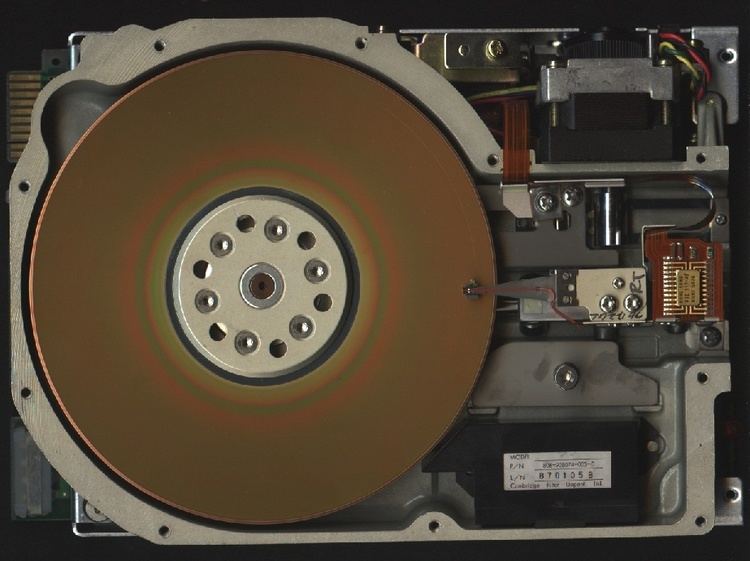 | ||
ST-506 can refer to either the hard disk drive (HDD) or its interface
Contents
The ST-506 hard disk drive was the first 5.25 inch hard disk drive, introduced in 1980 by Shugart Technology (now Seagate Technology). It stored up to 5 megabytes after formatting and cost US $1,500 ($4,360 in today's dollars). The similar, 10-megabyte ST-412 was introduced in late 1981. The ST-225 was introduced shortly thereafter with 20 megabytes and half the height. All three used MFM encoding, a widely used coding scheme. A subsequent extension of the ST-412 interface used RLL encoding for a 50% increase in capacity and bit rate.
The ST-506 connected to a computer system through a disk controller. The ST-506 interface between the controller and drive was derived from the Shugart Associates SA1000 interface, which was in turn based upon the floppy disk drive interface, thereby making disk controller design relatively easy.
The ST-506 interface and its variants (ST-412, ST-412RLL) were adopted by numerous HDD manufacturers such that the interface became a de facto industry standards for disk drives well into the 1990s.
The limitations of the ST-506 interface is 5.00 Mbit/s transfer rate, 16 heads, 4 drive units and a 20-foot (6.1 m) cable length. Number of tracks only increase the access time.
Interface to controller
In the ST-506 interface, the drive connects to a controller card with two data cables, while a third provides power. The control card translates requests for a particular track and sector from the host system into a sequence of head positioning commands, including setting the direction of head movement, in or out, and sending individual "STEP" commands to move. Four of the pins, "HD SLCT 0" through "HD SLCT 3", allow the selection among up to 16 heads, although only four are available on the two-platter ST-506. Once the heads are properly positioned, data is read or written serially through a set of pins in the 20-pin data cable. The limited bandwidth of the data cable was not an issue at the time and is not the factor that limited the performance of the system. However, the unshielded cable can sometimes be susceptible to high levels of noise.
The ST-412 disk drive, among other improvements, added buffered seek capability to the interface. In this mode, the controller can send STEP pulses to the drive as fast as it can receive them, without having to wait for the mechanism to settle. An onboard microprocessor then moves the mechanism to the desired track as fast as possible. The ST-506 disk drive without buffered seek, averages 170 ms (similar to a floppy drive or modern optical drive) while the mechanically very similar ST412 disk drive with buffered seek averages 85 ms. By the late 1980s, ST-412 drives were capable of average seek times between 15 and 30 milliseconds.
The process of moving portions of the command interpretation off the controller card and onto the drive itself in order to improve performance is a common feature of later hard drive connection schemes, notably the rich set of commands in SCSI, and the storage-focused IDE systems. IDE, in effect, is a system for extending the computer bus so the interface controller can be built into the drive enclosure rather than having to be plugged into the computer's backplane. This allows a single controller card to talk to multiple drives, as well as reducing latency and noise between the controller and drive hardware. In these systems, the operational details of the drive, like head selection and seeking, is entirely hidden from the host and handled within the drive's microprocessor. These became known as "smart" drives, while ST-506-like devices retroactively became known as "dumb".
Compatible systems and developments
Many other companies quickly introduced drives using the same connectors and signals, creating a hard drive standard based on the ST-506. IBM chose to use it, acquiring adapter cards for the PC/XT from Xebec and for the PC/AT from Western Digital. As a consequence of IBM's endorsement, most of the drives in the 1980s were based on the ST-506. However, the complexity of the controller and cabling led to newer solutions like SCSI, and later, ATA (IDE). A few early SCSI drives were actually ST-506 drives with a SCSI to ST-506 controller on the bottom of the drive; however, most SCSI and all ATA drives had built the controller into the drive, thereby eliminating the ST-506 interface in such models.
Connector pinouts
From ST506/ST412 OEM Manual In the following table, "~" denotes a negated (active low) signal.
